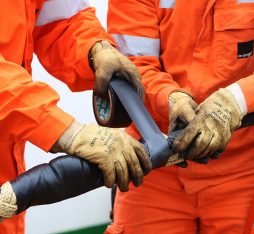Sophie Germain (1776–1831) was a French mathematician, physicist and philosopher who was an expert in number theory. Without her, the Eiffel Tower would probably not exist due to her work on the physics problem of elasticity. Self-taught, she became the first woman to receive the Mathematical Sciences Grand Prize from the French Academy of Sciences in 1816.
It took 18 months to draw up the exacting parameters for the specifications of this cable ship, which will consist of 4000 metric tons of steel and be 100 meters long and 18 meters wide.
Orange Marine has named its new cable ship in her honor. She will be the first ship designed specifically for repairing all types of submarine cables, whether optical fiber telecommunications cables or power cables connecting offshore wind turbines.
Repair vessels are of increasing strategic importance for maintaining global Internet connectivity, more than 98% of which relies on submarine cables. However, despite optimized route planning and protective measures taken during installation, there are, unfortunately, regular interruptions to the operation of these submarine cables. Such interruptions can cause major disruptions to the functioning of the Internet and international telecommunications services. In such cases, a cable ship must take action as soon as possible.
A Maintenance Vessel with a Strong Environmental Commitment
The latest addition to Orange Marine’s fleet has been designed to be operational within 24 hours year round. Her development also represents a significant commitment to the environment, as she will eventually replace the Raymond Croze, the oldest cable ship, which was launched in 1983. Her specifications include a 25% reduction in fuel consumption compared to average existing cable ships. “It’s a key driver in saving energy!” said Hugo Plantet, QSE Manager at Orange Marine.
To achieve this, it was necessary to study the Sophie Germain’s hull design. A ship interacts with two elements: the submerged part with the water and the part above the water with the air. For the former, hydrodynamic studies are conducted in large pools (or ship model basins) where real sea conditions such as wind, waves or currents are recreated. The reactions of the model boat’s hull are then measured. “Impacts on speed as well as stability are tested above all, so the hull design can be optimized to the best possible degree.” For the latter, tests have been carried out so that the effect of the wind (or windage) on the ship is reduced as far as possible, thereby limiting the risks of drift. These tests may even result in the ship having fewer decks than in the original design. “We made this decision for the Sophie Germain, which will have one deck fewer than the other cable ships.”
4000 Metric Tons of Steel, 100 m Long and 18 m Wide
In total, it took 18 months to draw up the exacting parameters for the specifications of this cable ship, which will consist of 4000 metric tons of steel and be 100 meters long and 18 meters wide. She will travel at a speed of 12 knots and her target fuel consumption has been contractually planned. “If discrepancies are noted once the ship sets sail, the manufacturer will be penalized,” said Hugo Plantet.
Fuel consumption has been reduced in particular thanks to Azipod technology, which uses azimuth thrusters capable of rotating 360°. The flow is thus optimally directed and allows the ship to be highly maneuverable to remain on course with a defined heading whatever the external elements. This type of propeller also makes it possible to replace the rudder by connecting the electric motor to the underwater propeller, “like on a speedboat.”
A Hybrid Ship, Combining Generators and Batteries
Another technological feature is the generators, which are essential for all diesel-electric systems, such as those used on cable ships. On the Sophie Germain, they will be able to produce up to 6 megawatts of electricity (divided into 2 x 2 megawatts and 2 x 1 megawatts) to power the propellers, and will be used alongside batteries. This so-called “hybrid” configuration will reduce the number of generators used while maintaining the redundancy needed for safe maintenance of cables if a generator unexpectedly shuts down. “We can thus prevent being in a blackout situation, which simply cannot be allowed to happen from a safety and operational standpoint — especially if, for example, we were welding an optical cable. The backup battery system takes over from the failed generator while reducing the boat’s fuel consumption,” Hugo Plantet explained.
In order to reduce the environmental footprint in terms of nitrogen oxide emissions, the ship has a system similar to a catalytic converter on diesel exhausts. When she has been docked, the ship will be electrically connected to the land-based network and will not produce any direct emissions. Solar panels installed in her home port in La Seyne-sur-Mer will supply her with energy that is low in greenhouse gas emissions, covering a large part of her energy consumption when docked. Not to mention the low-sulfur diesel used by Orange Marine’s entire fleet.
Seawater into Fresh Water
Finally, the crew will consist of about 60 people, who will be able to live self-sufficiently for 35 days. The Sophie Germain will be able to store up to 400 m3 of fresh water for the different requirements on board the ship. If that weren’t enough, the cable ship is equipped with fresh water generator systems that convert seawater into fresh water by bringing it to a boil in a vacuum. Numerous methods have also been planned to reduce waste and reprocess it on land.
The ships of Orange Marine :
Orange Marine, a wholly owned subsidiary of the Orange Group, is responsible for laying and repairing submarine cables all over the world and for all types of customers. For over 100 years, it has been establishing a high-quality global telecommunications network: Where yesterday it was copper, today it is optical fibers. To do this, Orange Marine has a fleet of six cable ships and a survey vessel. Its ships have laid more than 280,000 kilometers of fiber-optic cables and carried out more than 670 repairs on routes, some of which were almost 6000 meters deep.
Pierre de Fermat
The Pierre de Fermat is designed to manage the installation and maintenance of all kinds of cables, whether submarine telecommunications cables or energy cables.
She was built in 2014. She is equipped with a submarine plow.
Length: 100 m
Width: 21.5 m
René Descartes
Built in 2002, the René Descartes is a multipurpose cable ship designed to lay and repair submarine fiber-optic systems. She is equipped with a submarine plow. This ship has installed more than 30,000 km of submarine cables, 8200 of which were buried.
The René Descartes is one of the biggest units in the world fleet.
She is also one of the most powerful:
- her engine allows her a towing capacity of 125 metric tons to keep pace with changes to submarine plows
- she may tug up to 65 metric tons without tug assistance against strong currents (2 knots) and crosswinds (25 knots).
Length: 144.5 m
Width: 22 m
Teliri
Built in 1996, this Elettra ship, a subsidiary of Orange, installs and maintains submarine cables all over the world. She is equipped with a submarine plow which can bury the cables during laying.
Length: 111.5 m
Width: 19 m
Antonio Meucci
This Elettra ship, a subsidiary of Orange, is a ship mainly used for maintaining submarine telecommunications cables in the Mediterranean and the Red Sea. She is currently based in Catania, Italy.
Built in 1987, she is equipped with:
- a 6300-kW propulsion system
- a cost-effective and efficient Dynamic Positioning system
- three tanks that can carry 2300 metric tons of cables
Length: 114 m
Width: 18.5 m
Léon Thévenin
Built in 1983, the Léon Thévenin is a multipurpose cable ship that specializes in maintenance operations.
Her propulsion system, coupled with a DP (Dynamic Positioning) system allows her to secure high levels of sea-keeping capabilities in difficult wind and current conditions. With her high freeboard, she can sail in deep seas in poor weather conditions.
She is currently based in Cape Town, South Africa to maintain cables in the South Atlantic and South-West Indian Ocean.
Length: 107 m
Width: 17.8 m
Raymond Croze
Built in 1983, the Raymond Croze cable ship is the sister ship of the Léon Thévenin.
She is currently based in La Seyne-sur-Mer to maintain cables in the Mediterranean, the Red Sea and the Black Sea.
Length: 107 m
Width: 17.8 m
Urbano Monti
Built in 2007 and acquired by Elettra in 2019, this multipurpose ship has been equipped with all the necessary equipment to carry out survey operations around the world.
Length: 60 m
Width: 16 m









